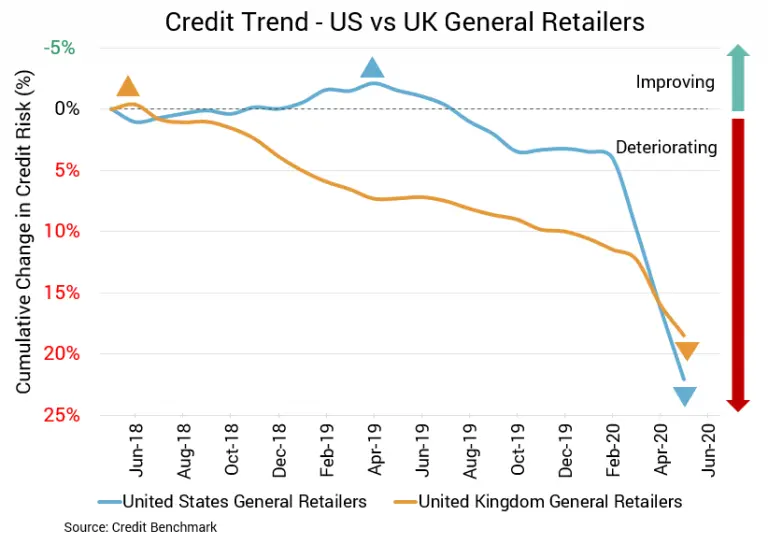To download the July 2020 Retail Aggregate PDF, click here.
The blows to the US retail sector continue. Well-known names declaring bankruptcy include Neiman Marcus, JC Penny, J. Crew, Tuesday Morning and GNC. More recently, Lucky Brand, Brooks Brothers, and Sure La Table have joined the list. One analysis is even suggesting the recent COVID-19-induced hit to retail is worse than that experienced during the Great Recession. The news is no better in the UK, where JD Sports seems likely to enter administration; alongside Victoria’s Secret UK, Debenham’s, Laura Ashley, and DVF Studio earlier this year. Job cuts continue in both the US and UK at all levels and unemployment levels grow as economies struggle to recover.
Each Month Sees Worsening Credit Trend
- Credit deterioration for US retailers has increased by an average of 6% in each of the last three months.
- Deterioration for UK firms is slower, but the overall probability of default risk remains higher for UK retail sector.
- Both the US and UK general retail aggregates continue to hit new credit quality lows.

US General Retail Firms
The decline in credit quality for US general retail firms continues to hasten, with deterioration averaging 6% in each of the last three months. The latest update shows a steep drop of 6% month-over-month, 11.8% over the last two months, and 18.8% over the last three months. On a year-over-year basis, the drop is 23.9%. Average probability of default for this sector is now 57 basis points, compared to 54 basis points in the prior month, 51 basis points two months prior, and 48 basis points three months prior. At the same point last year, average probability of default was 46 basis points. Approximately 80% of firms this aggregate with a CBC rating are at bbb or lower with the most recent update, and the overall CBC rating for this aggregate is bb+.
UK General Retail Firms
Credit quality also continues to worsen for UK general retail firms. The latest data show a drop of 1% month-over-month and 6% over the last two months. Year-over-year, credit quality deteriorated by 10.3%. Average probability of default for UK general retail firms remains significantly higher than that of their US counterparts. It’s now 75 basis points – just three points away from a downgrade to a CBC score of bb-. At the same point last year, average probability of default was 68 basis points. The percentage of firms in this aggregate with a CBC rating of bbb or lower (92%) is higher than with the US aggregate. The overall CBC rating for this aggregate is bb+.
About Credit Benchmark Monthly Retail Aggregate
This monthly index reflects the aggregate credit risk for US and UK General Retailers. It illustrates the average probability of default for companies in the sector to achieve a comprehensive view of how sector risk will be impacted by trends in the retail industry. A rising probability of default indicates worsening credit risk; a decreasing probability of default indicates improving credit risk. The Credit Benchmark Consensus (CBC) Rating is a 21-category scale explicitly linked to probability of default estimates sourced from major financial institutions. The letter grades range from aaa to d.
Credit Benchmark brings together internal credit risk views from 40+ of the world’s leading financial institutions. The contributions are anonymized, aggregated, and published in the form of entity-level consensus ratings and aggregate analytics to provide an independent, real-world perspective of risk. Consensus ratings are available for 50,000+ financials, corporate, funds, and sovereign entities globally across emerging and developed markets, and 75% of the entities covered are otherwise unrated.



